Flying with pets for the holidays? Check pet policies on the largest airlines in the US
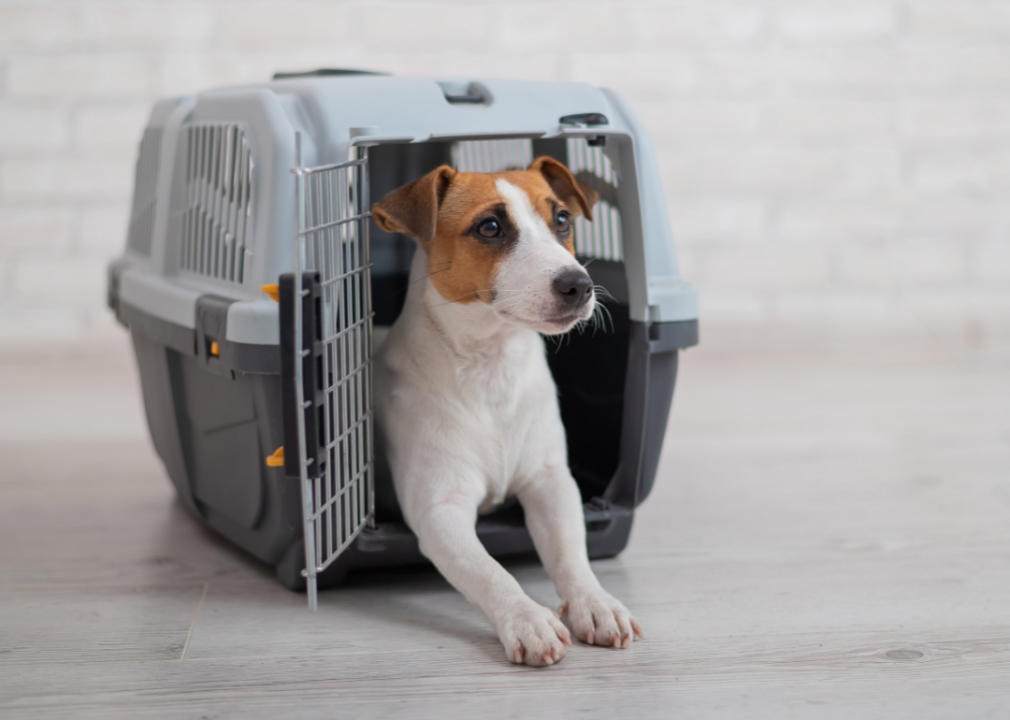
Canva
Flying with pets for the holidays? Check pet policies on the largest airlines in the US
A Jack Russel Terrier waits at the airport in a grey and black carrier.
Many pet owners prefer traveling with their fluffy companions, and most airlines make it possible to bring them on board. That said, traveling with Fido may take more preparation than just packing your bag.
Airlines typically allow small pets in carriers in the passenger cabin for an additional fee. Some large dog owners test those limits. In 2023, traveler Gabriel Bogner bought two extra seats for his Great Dane to travel with him on a cross-country flight, but that strategy may not work for everyone.
Flying can be stressful for pets, so their comfort is important. The International Air Transport Association has guidelines for how large pet carriers must be to ensure your pet’s comfort, yet fit underneath the seat or in the cargo hold. Many airlines consider pets to be a passenger’s carry-on item, so you’ll only be able to bring a personal item on board in addition to your furry companion.
Some dogs need a little more TLC before they fly. The American Veterinary Medical Association notes that short-nosed dogs like pugs, boxers, and bulldogs can have more problems with breathing or overheating, particularly when they’re stressed or experience temperature fluctuations, which can happen in a cargo hold. Some airlines, like Delta, restrict the breeds it will fly. If you own these types of dogs, know the risks and allow time for training your pet to weather the flight.
Service animals have fewer restrictions and no fees, but don’t expect to bring just any animal on board with that classification. In 2021, the Federal Aviation Administration put an end to flying with emotional support animals that could range from ducks to pigs by ruling that only dogs trained specifically to assist with their human’s disability can be called service animals. If you’re flying with a service dog, you may need to show the airline a special form for them to fly.
In August 2024, the CDC released new international entry requirements for dogs, so if you’re bringing a canine into the U.S., make sure you fill out the correct paperwork ahead of time.
To help travelers and their furry family members prepare for their flight, CitizenShipper explored the pet policies of the five largest U.S. airlines. The largest U.S. airlines were defined as those with the highest passenger-mile volume from July 2022 to June 2023 according to the Bureau of Transportation Statistics. Pet owners should always double-check with airlines well before flying to ensure the airline’s pet policies haven’t changed.
![]()
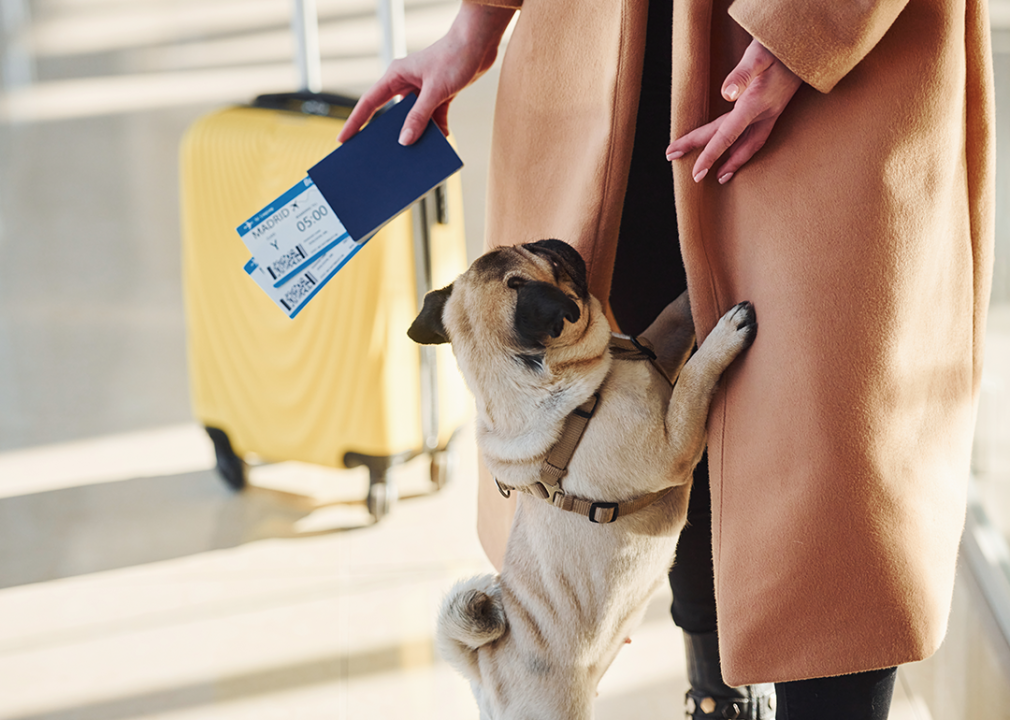
Standret // Shutterstock
Alaska Airlines
Pug dog with owner in airport.
On Alaska Airlines, trained service animals fly free, but the airline currently charges $100 to $150 per pet depending on whether they fly in the cabin or in the baggage compartment. Alaska Airlines allows dogs, cats, rabbits, and household birds to travel in its main cabin, but they must fit in a carrier that you can stow under the seat.
Owners must reserve a spot for their pet before the day of travel, and space is limited—first class has space for three pet carriers per flight, while the main cabin has room for eight carriers.
Pets weighing up to 150 lbs. (including its carrier) can travel in the baggage compartment. This includes cats, dogs, rabbits, household birds, nonpoisonous reptiles, hamsters, ferrets, guinea pigs, potbellied pigs, and tropical fish.
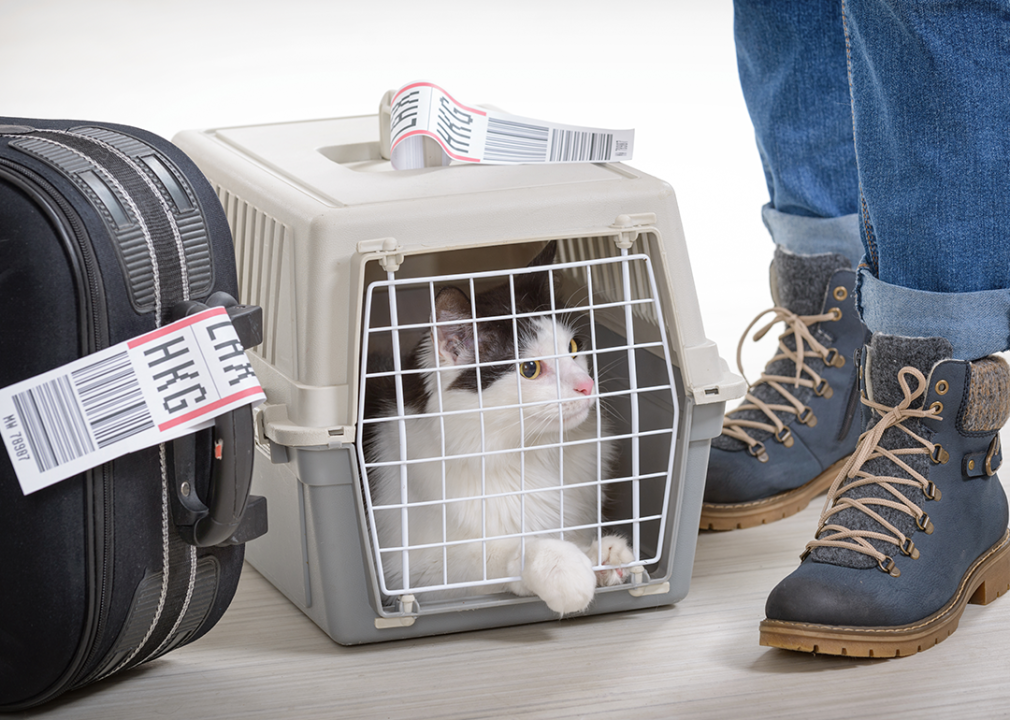
Monika Wisniewska // Shutterstock
United Airlines
Cat in carrier beside suitcase.
United no longer transports pets in cargo holds—the airline suspended that program, called PetSafe, in 2018 after several mishaps that included the death of a dog and dogs going to the wrong cities.
The airline now only allows passengers to carry on a cat or a dog. While the airline doesn’t have restrictions on breeds or weights, the pet must be able to stand up and turn around in a carrier that can fit under the seat in front of you, which does limit the size of pet you can bring on (unless it’s a service dog).
United’s fees for pets are currently $150 each way, with additional fees for domestic layovers that are more than four hours and international layovers that are more than 24 hours. United also does not allow pets to travel to Hawaii and a number of other countries, including Australia, the Philippines, and United Arab Emirates.
If bringing two pets, you must buy an additional ticket so you can place the carriers in the seat next to you.
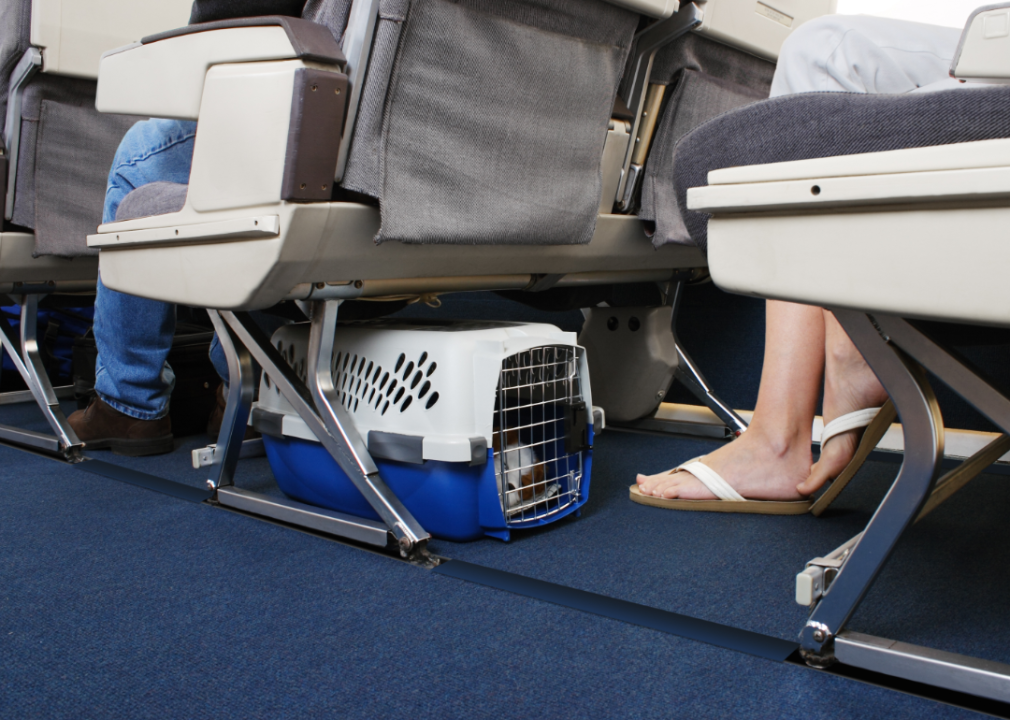
Canva
Southwest
Pet in carrier under seat in airplane.
Owners of small domestic cats and dogs can bring their pets on Southwest flights, provided they aren’t going to Hawaii or any international destination. Hawaii requires a quarantine period for incoming pets, other than service dogs, to maintain its rabies-free environment.
Pets require reservations, and owners must pay $125 each way per pet carrier. Flights have a limited number of spaces available for pets, and they’re offered on a first-come, first-served basis.
Cats and dogs need to stay in carriers from the time they arrive at the gate until they deplane at their destination. Each passenger can bring one pet carrier, but up to two pets of the same species can be in a carrier, provided they can stand and move around in that space.
During the flight, pets stay under the seat in front of their owner, which eliminates the opportunity to sit in the exit row or bulkhead. If you’re worried about the size of your carrier, Southwest does sell an approved version.
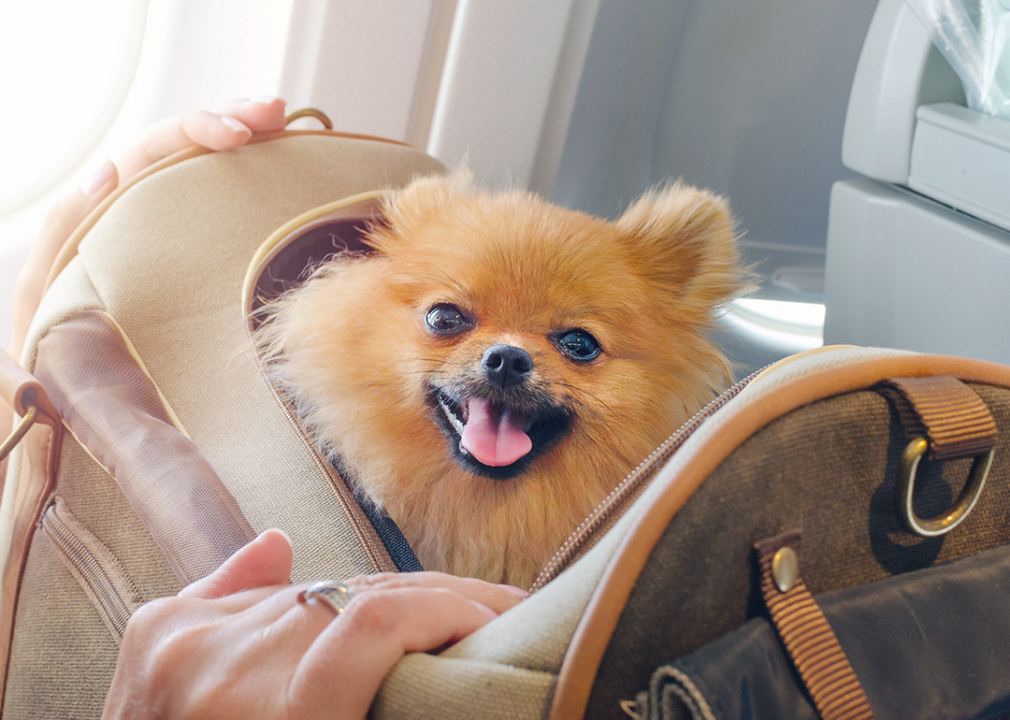
nadisja // Shutterstock
Delta
Pomeranian Spitz in a travel bag
Delta allows pet owners to take small dogs, cats, and household birds as carry-on luggage, provided they stay in a ventilated pet carrier that will fit under a seat. Because Delta flies so many different types of planes, it’s helpful to check the aircraft’s dimensions to make sure your carrier will fit before you fly.
Fees range from $75 to $200 each way, depending on your destination. If you’re traveling internationally, it’s important to find out whether your destination will allow incoming pets. Your destination country may also have age restrictions that can range from 8 weeks old to 16 weeks depending on the type of pet.
Although Delta has a program to fly larger dogs, cats, birds, reptiles, and amphibians through Delta Cargo, the company has temporarily embargoed this service, unless you’re an active military or foreign service officer with orders to permanently change stations.
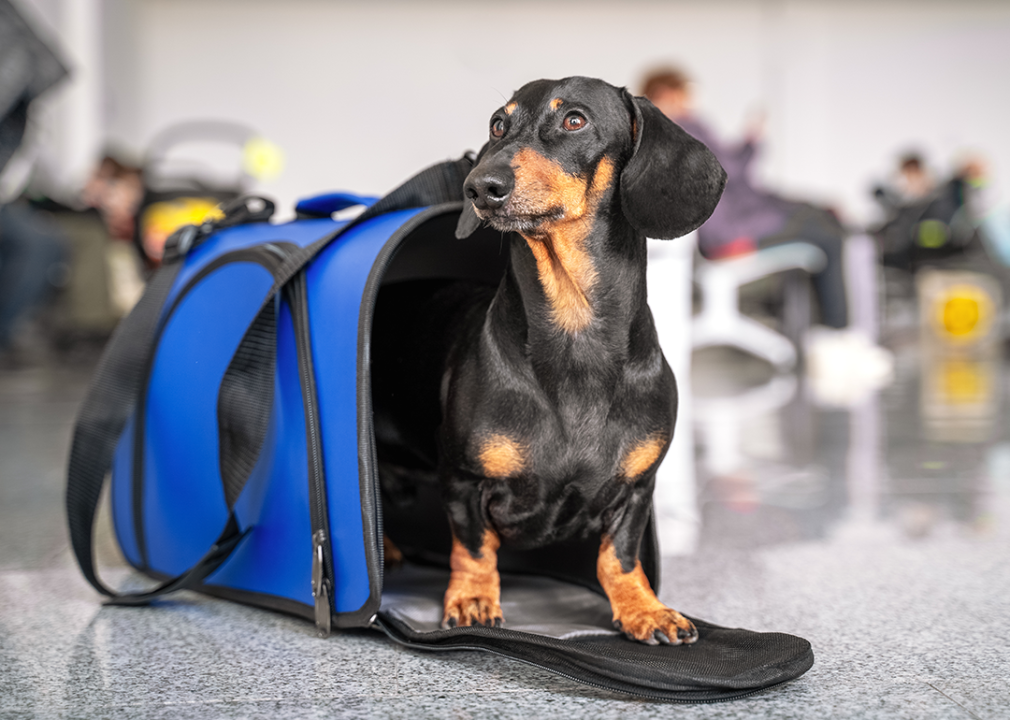
Masarik // Shutterstock
American Airlines
Dachshund in blue pet carrier before travel.
American Airlines only allows small cats and dogs that can fit in under-seat carriers in the aircraft cabin. The airline recommends using a soft-sided carrier because a hard-sided one may have issues fitting under the seat on American Eagle’s regional airplanes.
The airline only allows seven carriers on American flights and five on American Eagle, one of which is in first class, and spaces are available on a first-come, first-served basis. You’ll have to have your flight reservation first, then you can add a carry-on pet to it. The fee for carry-on pets is $150 each way.
Larger breeds must fly via American Airlines Cargo’s PetEmbark service and the cost can be estimated using their rate calculator. More planning may be necessary to ship larger animals—American won’t allow pets to travel in cargo in extreme heat or cold.
Story editing by Carren Jao. Copy editing by Tim Bruns.
This story originally appeared on CitizenShipper and was produced and distributed in partnership with Stacker Studio.
